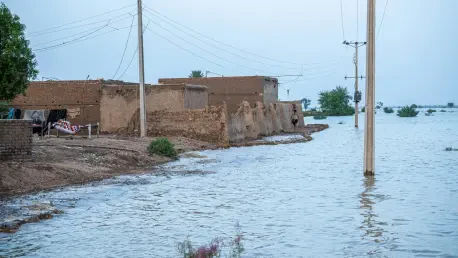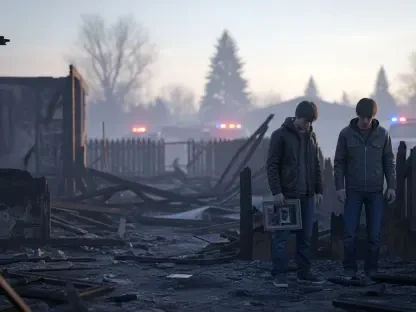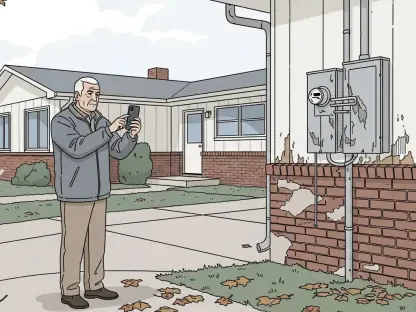Imagine a city where the serene beauty of towering glaciers masks a growing peril, as annual floods from melting ice threaten to wash away homes and livelihoods in Juneau, Alaska. This is not a distant fear but a stark reality, with the Mendenhall River recently cresting at unprecedented levels between 16.3 and 16.8 feet, forcing mass evacuations and damaging hundreds of properties. This roundup dives into the escalating crisis of glacial outburst floods, drawing on diverse perspectives from climate experts, local authorities, emergency responders, and insurance professionals. The purpose is to explore how Juneau is coping with these record-breaking events, compare varying opinions on mitigation and adaptation, and uncover actionable strategies for resilience in the face of a changing climate.
Understanding the Crisis: Diverse Views on Juneau’s Flooding
Climate Experts Weigh In on Escalating Threats
Climate specialists emphasize the undeniable link between Alaska’s rapid warming and the increasing frequency of glacial outburst floods. Data indicates that the region is heating at twice the rate of the continental United States, causing glacial basins like Suicide Basin near Mendenhall Glacier to release massive volumes of water almost yearly since the early 2010s. Many in the field argue that without significant global efforts to curb temperature rise, such events will only grow more severe over the coming decades.
A contrasting opinion among some researchers suggests that while climate change is a primary driver, local geological factors also play a critical role in the timing and impact of these floods. They point to the unique structure of ice dams and river pathways as elements that can either amplify or mitigate flooding risks. This perspective calls for more localized studies to complement broader climate models, ensuring that Juneau’s specific vulnerabilities are fully understood.
Local Authorities on Emergency Response Challenges
Municipal leaders and emergency management teams in Juneau describe the immediate aftermath of the floods as a logistical nightmare, with temporary barriers often proving insufficient against the sheer force of water. The deployment of thousands of Hesco barriers along miles of riverbank represents a significant effort to protect over 400 properties, yet officials admit that these measures are only stopgaps. Evacuation orders issued in the dead of night highlight the urgency and unpredictability of the situation.
Some local officials express frustration over the slow pace of permanent infrastructure solutions, noting that plans for engineered levees remain in the study phase with no clear timeline for implementation. They advocate for accelerated federal and state support to bridge the gap between short-term fixes and long-term defenses. This viewpoint underscores a tension between immediate action and the bureaucratic delays that hinder sustainable progress.
Mitigation and Adaptation: Comparing Strategies and Opinions
Emergency Responders Highlight Community Preparedness
Frontline responders stress the importance of community readiness in navigating flood crises, pointing to the effectiveness of early warning systems in saving lives during the latest surge. They praise local initiatives that educate residents on evacuation protocols and emergency kits, which have minimized casualties despite widespread property damage. Their insights suggest that grassroots efforts can make a significant difference in high-risk zones.
However, a differing take from some responders focuses on the emotional toll of repeated evacuations, observing that constant uncertainty erodes community morale. They argue for more psychological support services alongside physical preparations, proposing that mental health resources be integrated into disaster response plans. This angle reveals a less-discussed aspect of flood impacts, urging a holistic approach to resilience.
Insurance Professionals Debate Financial Protections
Within the insurance sector, there is growing concern that glacial floods transitioning from rare to regular events are disrupting traditional risk models. Industry voices warn that insured losses are climbing faster than economic growth worldwide, potentially leading to higher premiums that could price out many residents in vulnerable areas like Southeast Alaska. Some suggest that standard flood coverage may need drastic revision to remain viable.
On the other hand, a segment of insurance experts champions innovative solutions such as parametric insurance, where payouts are triggered by specific conditions like river levels rather than assessed damages. They believe this could streamline claims and provide quicker relief to affected households. This divergence in thought illustrates a broader debate on whether adaptation or reinvention is the best path forward for financial safeguards.
Long-Term Outlook: Balancing Nature and Necessity
Infrastructure Advocates Push for Permanent Solutions
Proponents of large-scale infrastructure projects argue that Juneau cannot rely indefinitely on temporary defenses against rising waters. They call for expedited funding and action on permanent levees, estimating that such measures could protect hundreds of homes from future floods projected to persist for another 25 to 60 years. Their stance is rooted in a belief that proactive investment outweighs the cost of repeated recovery.
A counterargument from budget-conscious planners highlights the enormous expense and environmental impact of such projects, questioning whether resources might be better allocated to relocation programs for the most at-risk neighborhoods. They propose a phased approach, blending smaller-scale protections with strategic retreat from flood-prone zones. This debate reflects the complex trade-offs between preservation and pragmatism in adaptation planning.
Community Voices on Living with Uncertainty
Residents and local advocacy groups bring a personal dimension to the discussion, describing the strain of living in a state of perpetual alert as floods become an annual expectation. Many express a desire for clearer communication from authorities about long-term risks and actionable steps they can take to safeguard their properties. Their input underscores the need for inclusive planning that prioritizes transparency.
A contrasting resident perspective focuses on collective action, with some community members organizing to lobby for flood-resistant building codes and shared resources for home modifications. They view individual efforts as vital supplements to governmental responses, fostering a sense of agency amid daunting challenges. This viewpoint highlights the potential for local empowerment to shape Juneau’s future resilience.
Reflecting on Juneau’s Flood Challenges and Paths Forward
Looking back on the myriad perspectives shared, it becomes clear that Juneau’s struggle with record glacial floods encapsulates a broader clash between nature’s accelerating changes and humanity’s capacity to adapt. Climate experts, emergency responders, insurance professionals, and community advocates all contributed unique insights, from the urgent need for better preparedness to the innovative potential of new financial tools. Their differing views paint a picture of a city at a crossroads, grappling with both immediate survival and long-term sustainability. Moving forward, stakeholders could consider prioritizing rapid infrastructure advancements, exploring hybrid insurance models like parametric coverage, and fostering community-driven resilience initiatives. Engaging with regional planning forums and staying informed about evolving flood risk assessments might also empower residents and policymakers alike to build a stronger, more adaptive Juneau in the years ahead.









